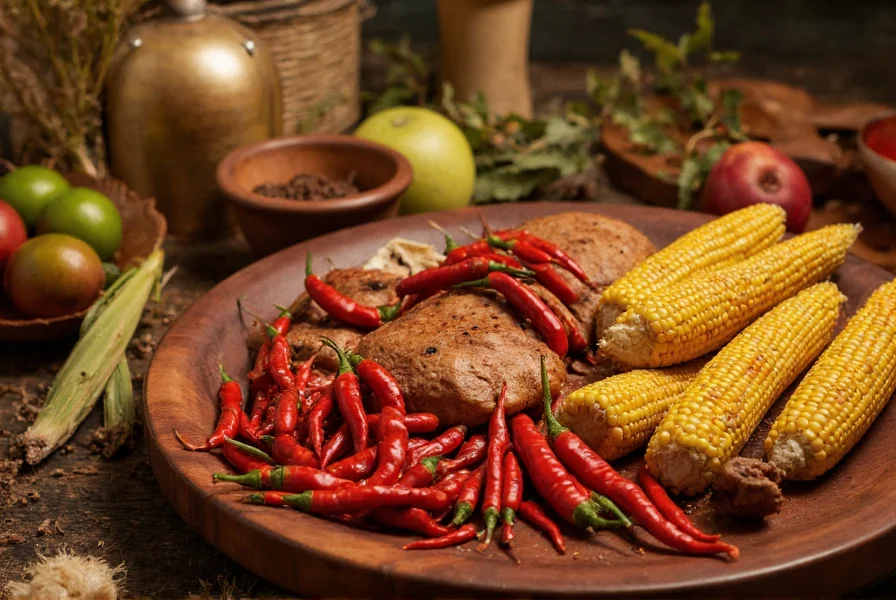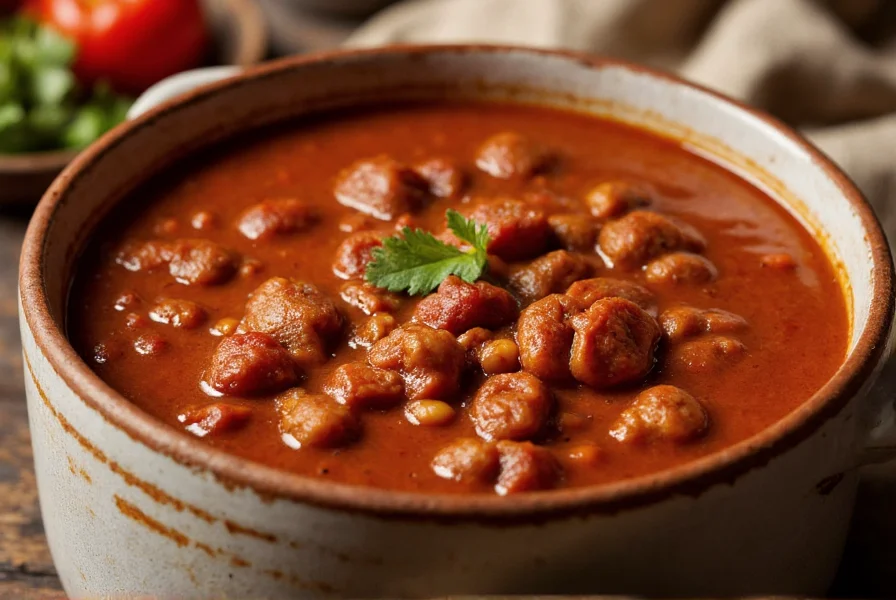When searching for who invented chili, many expect a single name, but the truth is far more complex and culturally rich. Chili con carne—literally "chili with meat"—emerged from centuries of culinary evolution rather than a single moment of invention. The dish we recognize today formed through the blending of indigenous Mesoamerican cooking traditions, Spanish colonial influences, and Texan frontier culture.
The Ancient Roots of Chili
Long before European contact, indigenous peoples across Mesoamerica cultivated chili peppers and developed sophisticated cooking techniques. The Aztecs and other pre-Columbian civilizations combined chili peppers with meat, tomatoes, and beans in stews that would become foundational to what we now call chili. Archaeological evidence shows chili peppers were domesticated in Mexico as early as 6000 BCE.

Spanish Colonization and Culinary Fusion
When Spanish conquistadors arrived in the 16th century, they introduced beef and other Old World ingredients to the region. This created a culinary fusion where indigenous chili-based sauces met European meats. The Spanish initially disliked the heat of chili peppers but eventually incorporated them into their cooking. By the 18th century, Spanish missionaries in what is now Texas were documenting dishes combining beef, chili peppers, and other local ingredients.
Texas Frontier and the Birth of Modern Chili
The version of chili that would become popular across America developed primarily in Texas during the 19th century. Mexican-American women known as chili queens sold their distinctive stew from street stands in San Antonio's plazas. These vendors perfected the recipe using affordable ingredients available to working-class communities—beef, chili peppers, and sometimes beans.
According to historical records from the 1880s, San Antonio's chili stands became so popular that they attracted tourists specifically to try this unique regional specialty. The history of chili recipe shows significant variation between vendors, with each adding their own family touches to the basic formula.
The 1893 World's Fair and National Popularity
Chili's journey to national prominence began at the 1893 World's Columbian Exposition in Chicago. Though not officially featured, Texas vendors set up informal stands selling chili con carne, introducing it to visitors from across America. The dish's hearty, affordable nature made it particularly appealing during the economic depression of the 1890s.
By the early 20th century, chili powder—which had been developed as a convenient way to preserve and transport chili flavor—became commercially available, further spreading chili's popularity beyond the Southwest. The first commercial chili powder was produced in New Braunfels, Texas, around 1908.
Common Misconceptions About Chili's Origin
Several myths persist about who invented chili con carne. Some claim it was created by cowboys who needed portable food on cattle drives, but historical evidence suggests chili was primarily an urban dish sold in cities like San Antonio. Others attribute it to Spanish missionaries, but while they did incorporate chili peppers into their cooking, the specific combination that became chili con carne developed later.
One persistent myth names a specific person as chili's inventor, but food historians agree this is inaccurate. As culinary expert Jane Roberts explains: "Chili evolved organically through community cooking traditions rather than being 'invented' by any single individual."
Chili vs. Mole: Understanding the Difference
Many confuse chili with mole, another Mexican sauce featuring chili peppers. While both use chili peppers as a primary ingredient, they differ significantly:
| Feature | Chili Con Carne | Mole |
|---|---|---|
| Primary Ingredients | Beef, chili peppers, sometimes beans | Chili peppers, chocolate, spices, nuts, seeds |
| Texture | Thick stew | Smooth sauce |
| Origin Region | Texas/Mexican border | Oaxaca, Puebla (Mexico) |
| Historical Development | 19th century frontier cooking | Colonial-era convent cooking |
How Chili Became an American Icon
The origin of Texas chili became cemented in American culture through several key developments:
- Early 1900s: Chili stands spread from San Antonio to other Texas cities and eventually across the Southwest
- 1920s-1930s: Chili parlors became popular during the Great Depression as affordable, hearty meals
- World War II: American soldiers stationed in Texas brought their taste for chili back home
- 1950s: Canned chili products made the dish accessible nationwide
The first published chili recipe appeared in 1904 in San Antonio Cook Book, but it differed significantly from modern versions, lacking beans which many traditionalists still consider inauthentic.
Modern Variations and Cultural Significance
Today, chili has become a culinary canvas with endless variations. The traditional chili ingredients have expanded to include regional adaptations from Cincinnati chili (served over spaghetti) to white chili (made with chicken and white beans). Despite these variations, the core elements remain: meat, chili peppers, and a rich, complex flavor profile.
Chili cook-offs have become popular competitive events across America, with the World Championship Chili Cook-Off founded in 1967. These events celebrate the dish's enduring appeal while honoring its multicultural roots.
Understanding the True History of Chili
When exploring how chili became popular in America, it's important to recognize that food traditions rarely have single points of origin. Chili con carne represents a beautiful example of culinary syncretism—where different cultures contribute to a shared food heritage. The Mexican-American communities of Texas didn't "invent" chili so much as they perfected and popularized a dish that had been evolving for centuries.
As food historian Dr. Michael Stern notes, "The story of chili is the story of America itself—diverse cultural elements blending to create something uniquely new while honoring its roots." This perspective helps us appreciate chili not just as a meal, but as a living piece of cultural history.
Who really invented chili con carne?
No single person invented chili con carne. The dish evolved over centuries through cultural blending, with its modern form developing in late 19th century Texas among Mexican-American communities, particularly in San Antonio's famous chili stands.
When did chili become popular in America?
Chili gained national popularity after being introduced at the 1893 World's Columbian Exposition in Chicago, though it had been a regional specialty in Texas since the mid-1800s. Its affordability made it particularly popular during the economic depression of the 1890s, and chili parlors spread across America during the Great Depression of the 1930s.
Did cowboys invent chili?
No, this is a common misconception. While chili was certainly eaten by cowboys, historical evidence shows it was primarily an urban dish sold by Mexican-American women in San Antonio's plazas. The "chili queens" of San Antonio were the true popularizers of the dish, not frontier cowboys.
What's the difference between chili and mole?
While both use chili peppers, they're distinct dishes. Chili con carne is a meat-based stew typically featuring beef and chili peppers (sometimes with beans), while mole is a complex sauce from Oaxaca and Puebla that includes chocolate, spices, nuts, and seeds alongside chili peppers. Mole has a smoother texture and more complex flavor profile than traditional Texas chili.
Why don't traditional Texas chili recipes include beans?
Authentic Texas-style chili (often called "chili con carne") traditionally omits beans because they were not part of the original recipes developed by Mexican-American cooks in Texas. Beans were considered a filler ingredient that diluted the rich meat and chili pepper flavors. Many chili purists still maintain that beans have no place in true Texas chili, though bean-containing versions are popular elsewhere in America.
Frequently Asked Questions
Who really invented chili con carne?
No single person invented chili con carne. The dish evolved over centuries through cultural blending, with its modern form developing in late 19th century Texas among Mexican-American communities, particularly in San Antonio's famous chili stands.
When did chili become popular in America?
Chili gained national popularity after being introduced at the 1893 World's Columbian Exposition in Chicago, though it had been a regional specialty in Texas since the mid-1800s. Its affordability made it particularly popular during the economic depression of the 1890s, and chili parlors spread across America during the Great Depression of the 1930s.
Did cowboys invent chili?
No, this is a common misconception. While chili was certainly eaten by cowboys, historical evidence shows it was primarily an urban dish sold by Mexican-American women in San Antonio's plazas. The "chili queens" of San Antonio were the true popularizers of the dish, not frontier cowboys.
What's the difference between chili and mole?
While both use chili peppers, they're distinct dishes. Chili con carne is a meat-based stew typically featuring beef and chili peppers (sometimes with beans), while mole is a complex sauce from Oaxaca and Puebla that includes chocolate, spices, nuts, and seeds alongside chili peppers. Mole has a smoother texture and more complex flavor profile than traditional Texas chili.
Why don't traditional Texas chili recipes include beans?
Authentic Texas-style chili (often called "chili con carne") traditionally omits beans because they were not part of the original recipes developed by Mexican-American cooks in Texas. Beans were considered a filler ingredient that diluted the rich meat and chili pepper flavors. Many chili purists still maintain that beans have no place in true Texas chili, though bean-containing versions are popular elsewhere in America.











 浙公网安备
33010002000092号
浙公网安备
33010002000092号 浙B2-20120091-4
浙B2-20120091-4